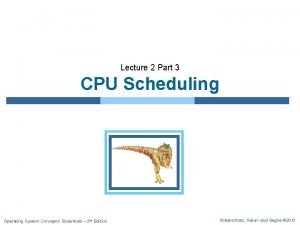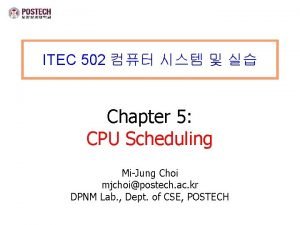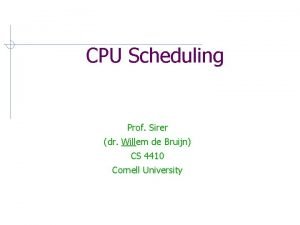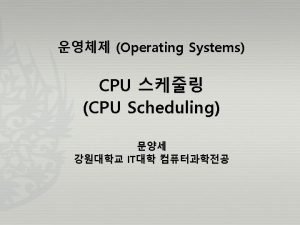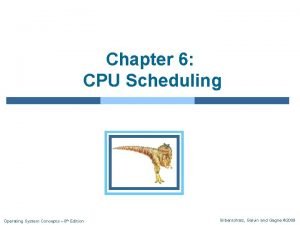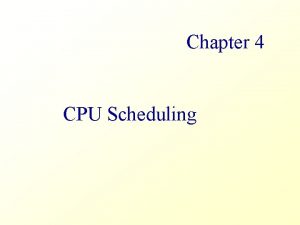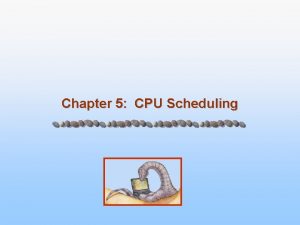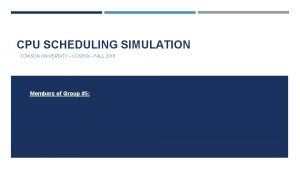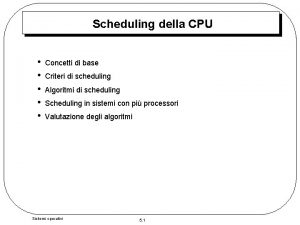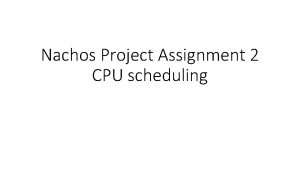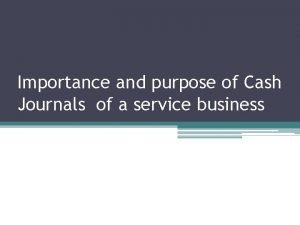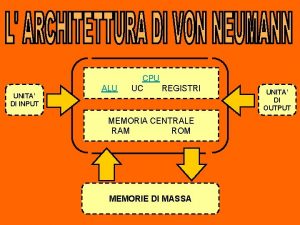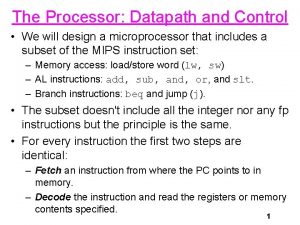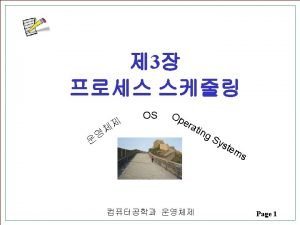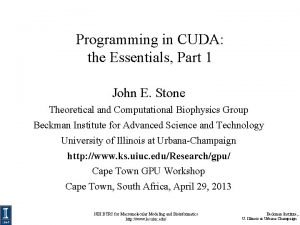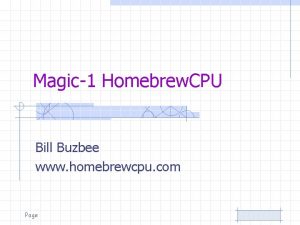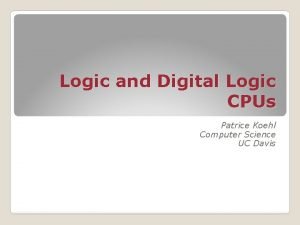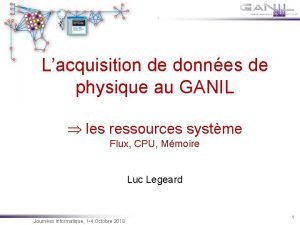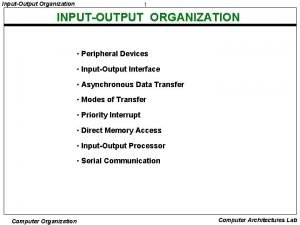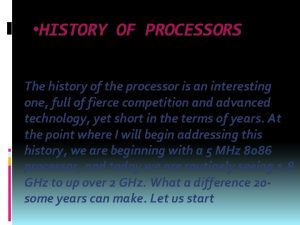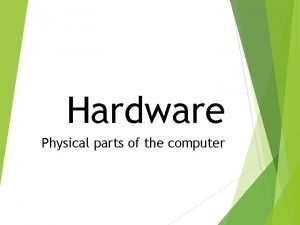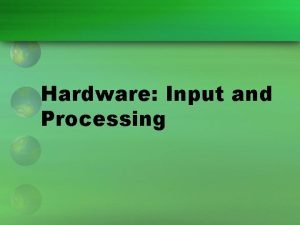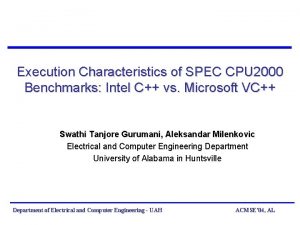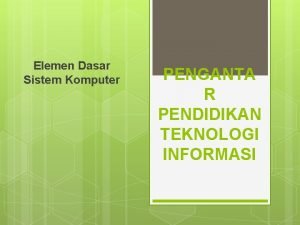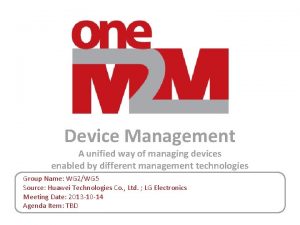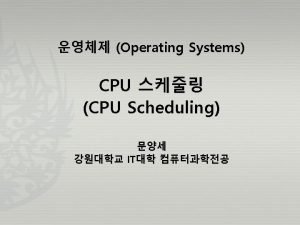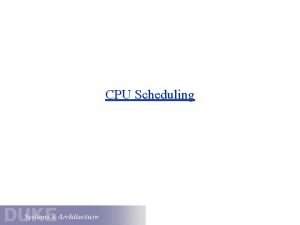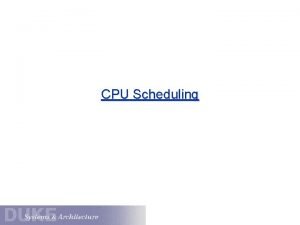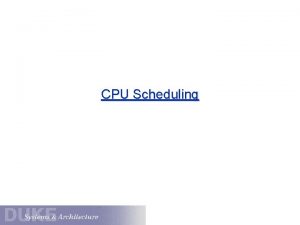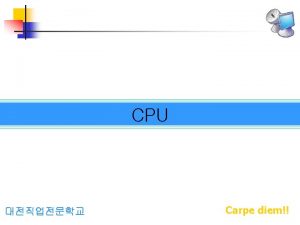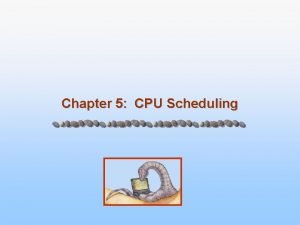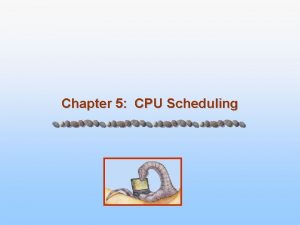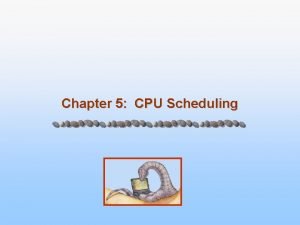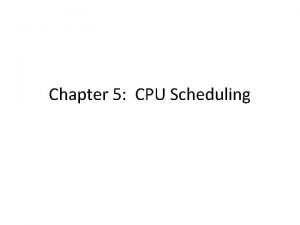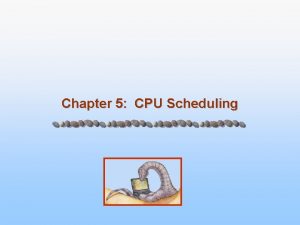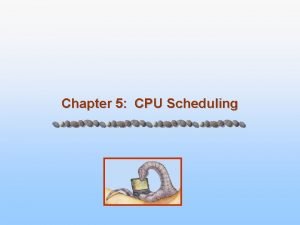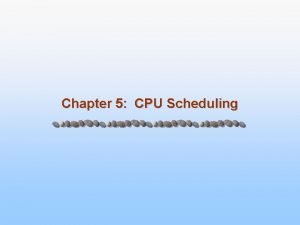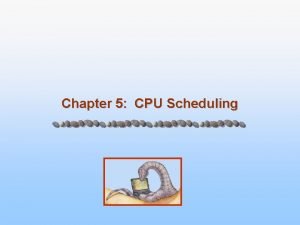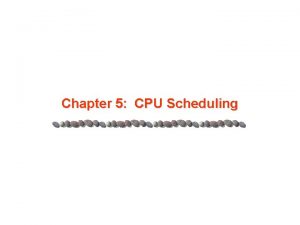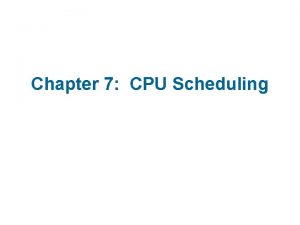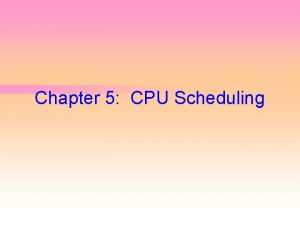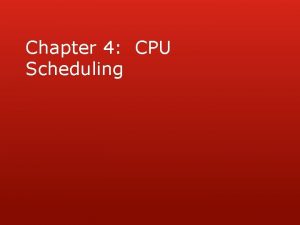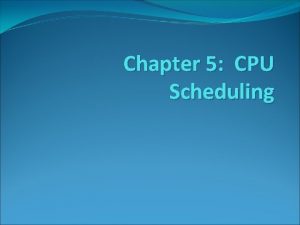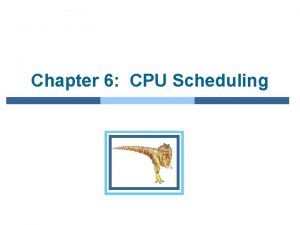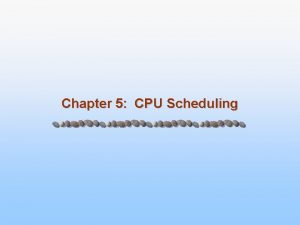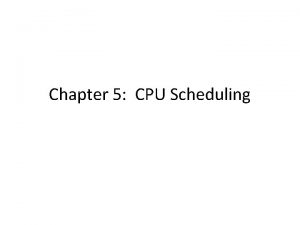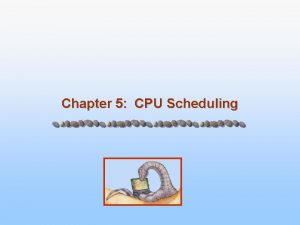Chapter 2 Scheduling Outline CPU Scheduling Importance of




































- Slides: 36

Chapter 2 Scheduling

Outline • CPU Scheduling • Importance of scheduling in diff. environment • CPU bound process, I/O bound process • Preemptive, non-preemptive scheduling • Batch system scheduling algorithms • FCFS, Shortest Job First, Shortest Remaining First • Interactive system scheduling • RR, Priority scheduling, Lottery Scheduling • Realtime system scheduling • Thread Scheduling • User-level thread • Kernel-level thread

Process States Figure 2 -2. A process can be in running, blocked, or ready state. Transitions between these states are as shown. Tanenbaum, Modern Operating Systems 3 e, (c) 2008 Prentice-Hall, Inc. All rights reserved. 0 -13 - 6006639

Modeling Multiprogramming Figure 2 -6. CPU utilization as a function of the number of processes in memory. Tanenbaum, Modern Operating Systems 3 e, (c) 2008 Prentice-Hall, Inc. All rights reserved. 0 -13 - 6006639

Process Control Table Figure 2 -4. Some of the fields of a typical process table entry. Tanenbaum, Modern Operating Systems 3 e, (c) 2008 Prentice-Hall, Inc. All rights reserved. 0 -13 - 6006639

Process Scheduling Queues • Job queue – set of all processes in the system • Ready queue – set of all processes residing in main memory, ready and waiting to execute • Device queues – set of processes waiting for an I/O device • Processes migrate among the various queues

Ready Queue And Various I/O Device Queues • Ready queue – processes residing in main memory, ready and waiting to execute • Device queues – processes waiting for an I/O device • Processes migrate among the various queues

Representation of Process Scheduling

Schedulers • When to schedule? • when a process is created, or exits • when a process blocks on I/O, semaphore, mutex… • interrupts: hardware or software • timer interrupt: nonpreemptive vs preemptive scheduling • Long-term scheduler (or job scheduler) – selects which processes should be brought into the ready queue • Short-term scheduler (or CPU scheduler) – selects which process should be executed next and allocates CPU

Schedulers • Short-term scheduler is invoked very frequently (milliseconds) ⇒(must be fast) • Long-term scheduler is invoked very infrequently (seconds, minutes) ⇒(may be slow) • The long-term scheduler controls the degree of multiprogramming • Processes can be described as either: – I/O-bound process – spends more time doing I/O than computations, many short CPU bursts – CPU-bound process – spends more time doing computations; few very long CPU bursts

Process Behavior Bursts of CPU usage alternate with periods of waiting for I/O. (a) A CPU-bound process. (b) An I/O-bound process. Tanenbaum, Modern Operating Systems 3 e, (c) 2008 Prentice-Hall, Inc. All rights reserved. 0 -13 - 6006639

Categories of Scheduling Algorithms • Batch system: business application, no end users • non-preemptive, preemptive • Interactive system: with interactive users, or server (with multiple remote interactive users) • preemption • Real time system: Tanenbaum, Modern Operating Systems 3 e, (c) 2008 Prentice-Hall, Inc. All rights reserved. 0 -13 - 6006639

Scheduling Algorithm Goals Tanenbaum, Modern Operating Systems 3 e, (c) 2008 Prentice-Hall, Inc. All rights reserved. 0 -13 - 6006639

Scheduling in Batch Systems • • • First-come first-served Shortest job first Shortest remaining Time next Tanenbaum, Modern Operating Systems 3 e, (c) 2008 Prentice-Hall, Inc. All rights reserved. 0 -13 - 6006639

First Come First Served • First-come first-served • • • processes assigned CPU in order of request when running process blocks, schedule next one in queue when blocking process becomes ready, enter end of queue Pros: simple, easy to implement, fair (in some sense) Cons: • • short jobs arrive after a very long job one compute-bound process (1 sec at a time), many IObound processes (perform 1000 disk reads) => take a long time to finish I/O bound process Tanenbaum, Modern Operating Systems 3 e, (c) 2008 Prentice-Hall, Inc. All rights reserved. 0 -13 - 6006639

Shortest Job First • • • Assumption: run time for processes are known in advance Scheduler: among equally important jobs in ready queue, pick the one with the shortest run time. Proof: Shortest Job First yields smallest average turnaround time, if all jobs are available simultaneously. Tanenbaum, Modern Operating Systems 3 e, (c) 2008 Prentice-Hall, Inc. All rights reserved. 0 -13 - 6006639

Shortest Job First Figure 2 -40. An example of shortest job first scheduling. (a) Running four jobs in the original order. (b) Running them in shortest job first order. Tanenbaum, Modern Operating Systems 3 e, (c) 2008 Prentice-Hall, Inc. All rights reserved. 0 -13 - 6006639

Shortest Remaining Time next • • Jobs/Processes can arrive at different time Preemptive version of Shortest Job First • • • When new job arrives, if its run time is smaller than current process’s remaining time, schedule the new job Some kind of greedy algorithm: keep the ready queue as short as possible Question: Does this scheme minimize average turnaround time? Tanenbaum, Modern Operating Systems 3 e, (c) 2008 Prentice-Hall, Inc. All rights reserved. 0 -13 - 6006639

Scheduling in Interactive Systems • • Round-robin scheduling Priority scheduling Multiple queues Shortest process next Guaranteed scheduling Lottery scheduling Fair-share scheduling Tanenbaum, Modern Operating Systems 3 e, (c) 2008 Prentice-Hall, Inc. All rights reserved. 0 -13 - 6006639

Round-Robin Scheduling • A process, when scheduled to run, is assigned the CPU for a time interval, quantum • • • If process blocks or finishes before quantum expires, CPU switches to run other process If still running at end of quantum, preempt and schedule other process to run Length of quantum • • • too short => too much context switch overhead too long => system not responsive/interactive typical setting: 20 -50 msec Tanenbaum, Modern Operating Systems 3 e, (c) 2008 Prentice-Hall, Inc. All rights reserved. 0 -13 - 6006639

Round-Robin Scheduling Figure 2 -41. Round-robin scheduling. (a) The list of runnable processes. (b) The list of runnable processes after B uses up its quantum. Tanenbaum, Modern Operating Systems 3 e, (c) 2008 Prentice-Hall, Inc. All rights reserved. 0 -13 - 6006639

Priority Scheduling • Idea: assign each process a priority, ready processes with highest priority is scheduled to run Setting priority • • based upon the process’s user ID: position, payment higher priority for interactive process, lower priority for background process => to be responsive dynamically assigned • • • e. g. , give higher priority to I/O bound process Tanenbaum, Modern Operating Systems 3 e, (c) 2008 Prentice-Hall, Inc. All rights reserved. 0 -13 - 6006639

Priority Scheduling: data structure Run for one quantum Run for 2 quanta Run for 4 quanta Run for 8 quanta Example (CTSS) • CPU bound process will sink to long priority queue • If used up quantum, move down one class • larger quantum => cut context switch overhead • I/O bound process will stay at high priority queue Tanenbaum, Modern Operating Systems 3 e, (c) 2008 Prentice-Hall, Inc. All rights reserved. 0 -13 - 6006639

Interactive Systems: shortest process next • Interactive process: 1. wait for command 2. execute command 3. go back to 1 • To minimize response time (step 2 above), schedule process with shortest running time • Estimate running time of a process’s step 2 using history (weighted average, aging) • Te’ = a. Te + (1 -a) Ti • Te: current estimation • Te’: new estimation • Ti: current measured running time Tanenbaum, Modern Operating Systems 3 e, (c) 2008 Prentice-Hall, Inc. All rights reserved. 0 -13 - 6006639

Interactive Systems: Lottery Scheduling • • A randomized scheme each process given lottery tickets for CPU resource Scheduler: choose a lottery ticket at random, the process holds the ticket is the scheduled to run • The more tickets a process holds, the higher probability of scheduled to run Pros: • proportional allocation of CPU • allow transferring of tickets among cooperating processes, Tanenbaum, Modern Operating Systems 3 e, (c) 2008 Prentice-Hall, Inc. All rights reserved. 0 -13 - 6006639

Scheduling in Real-time Systems • Realtime system: must react to external events within a fixed amount of time Periodic events vs aperiodic events • • e. g. , in vo. IP system, incoming audio packets are periodic events in intrusion detection system, detected abnormal signal is an aperiodic event Hard real time • absolute deadline • Soft real time • soft deadline: ok to miss occasionally, Tanenbaum, e. g. , Modern Operating Systems 3 e, (c) 2008 system Prentice-Hall, Inc. All rights reserved. 0 -13 - 6006639 multimedia

Outline • CPU Scheduling • Importance of scheduling in diff. environment • CPU bound process, I/O bound process • Preemptive, non-preemptive scheduling • Batch system scheduling algorithms • FCFS, Shortest Job First, Shortest Remaining First • Interactive system scheduling • RR, Priority scheduling, Lottery Scheduling • Realtime system scheduling • Thread Scheduling • User-level thread • Kernel-level thread

Thread Scheduling (1) Figure 2 -43. (a) Possible scheduling of user-level threads with a 50 -msec process quantum and threads that run 5 msec per CPU burst. Tanenbaum, Modern Operating Systems 3 e, (c) 2008 Prentice-Hall, Inc. All rights reserved. 0 -13 - 6006639

Thread Scheduling (2) Figure 2 -43. (b) Possible scheduling of kernel-level threads with the same characteristics as (a). Tanenbaum, Modern Operating Systems 3 e, (c) 2008 Prentice-Hall, Inc. All rights reserved. 0 -13 - 6006639

Dining Philosophers Problem (1) Figure 2 -44. Lunch time in the Philosophy Department. Tanenbaum, Modern Operating Systems 3 e, (c) 2008 Prentice-Hall, Inc. All rights reserved. 0 -13 - 6006639

Dining Philosophers Problem (2) Figure 2 -45. A nonsolution to the dining philosophers problem. Tanenbaum, Modern Operating Systems 3 e, (c) 2008 Prentice-Hall, Inc. All rights reserved. 0 -13 - 6006639

Dining Philosophers Problem (3) . . . Figure 2 -46. A solution to the dining philosophers problem. Tanenbaum, Modern Operating Systems 3 e, (c) 2008 Prentice-Hall, Inc. All rights reserved. 0 -13 - 6006639

Dining Philosophers Problem (4). . . Figure 2 -46. A solution to the dining philosophers problem. Tanenbaum, Modern Operating Systems 3 e, (c) 2008 Prentice-Hall, Inc. All rights reserved. 0 -13 - 6006639

Dining Philosophers Problem (5). . . Figure 2 -46. A solution to the dining philosophers problem. Tanenbaum, Modern Operating Systems 3 e, (c) 2008 Prentice-Hall, Inc. All rights reserved. 0 -13 - 6006639

The Readers and Writers Problem (1) . . . Figure 2 -47. A solution to the readers and writers problem. Tanenbaum, Modern Operating Systems 3 e, (c) 2008 Prentice-Hall, Inc. All rights reserved. 0 -13 - 6006639

The Readers and Writers Problem (2). . . Figure 2 -47. A solution to the readers and writers problem. Tanenbaum, Modern Operating Systems 3 e, (c) 2008 Prentice-Hall, Inc. All rights reserved. 0 -13 - 6006639
 Turnaround time in os
Turnaround time in os Priority scheduling
Priority scheduling Sjf cpu scheduling
Sjf cpu scheduling Fcfs calculator
Fcfs calculator Sjf cpu scheduling
Sjf cpu scheduling Sjf cpu scheduling
Sjf cpu scheduling Cpu scheduling types
Cpu scheduling types Preeptive
Preeptive Cpu scheduling project
Cpu scheduling project Scheduling della cpu
Scheduling della cpu Cpu scheduling project
Cpu scheduling project Job scheduling vs process scheduling
Job scheduling vs process scheduling It in a sentence
It in a sentence Outline the importance of cash journal
Outline the importance of cash journal Alu uc
Alu uc Cpu datapath
Cpu datapath Cpu vs io
Cpu vs io Partes internas y externas de una computadora
Partes internas y externas de una computadora Rom ram cpu
Rom ram cpu John cuda
John cuda Partes de un case
Partes de un case In this scheme cpu execution waits while i/o proceeds.
In this scheme cpu execution waits while i/o proceeds. Microprocessor accumulator
Microprocessor accumulator Homebrew cpu
Homebrew cpu Cpu consists of
Cpu consists of Cpu
Cpu Input output organization
Input output organization Kernel: initializing cgroup subsys cpuset
Kernel: initializing cgroup subsys cpuset Maqueta de las partes internas del cpu
Maqueta de las partes internas del cpu History of processors
History of processors Hertz cpu
Hertz cpu Digital devices
Digital devices Microsegundos
Microsegundos Cpu 2000
Cpu 2000 Yang tidak termasuk elemen dari sistem komputer adalah
Yang tidak termasuk elemen dari sistem komputer adalah Device management unified communications
Device management unified communications Cpu funktionsweise
Cpu funktionsweise
